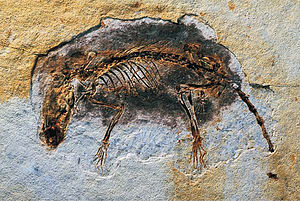Eomaia scansoria
| Eomaia scansoria | ||||||||||||
|---|---|---|---|---|---|---|---|---|---|---|---|---|

Holotype of Eomaia scansoria , the shadowy preservation of the fur is clearly visible |
||||||||||||
| Temporal occurrence | ||||||||||||
| Barremium ( Lower Cretaceous ) | ||||||||||||
| 130 to 125 million years | ||||||||||||
| Locations | ||||||||||||
| Systematics | ||||||||||||
|
||||||||||||
| Scientific name of the genus | ||||||||||||
| Eomaia | ||||||||||||
| Ji et al. , 2002 | ||||||||||||
| Scientific name of the species | ||||||||||||
| Eomaia scansoria | ||||||||||||
| Ji et al., 2002 | ||||||||||||
Eomaia scansoria is an extinct mammal that is considered to be one of the oldest representatives of the higher mammals (Eutheria).
Its remains come from the sedimentary rocks of the Jehol group in the Chinese province of Liáoníng . Eomaia thus lived in the Barremium (younger Lower Cretaceous ), about 125 million years ago.
etymology
The binomial Eomaia scansoria means something like "climbing early mother".
description
The fossil is 10 centimeters long and almost completely intact. The body weight of the living animal is estimated to be 20-25 grams. For a 125-million-year-old fossil, it is exceptionally well preserved. Although the skull is flattened, teeth, small foot bones, cartilage, and even fur can be seen.
The narrowness of the basin suggests that Eomaia gave birth to live young , but they were not well developed. This is an indication of a poorly developed placenta .
The first description , according to the animal had a bag bone . It is most unusual for higher mammals, but known from early representatives. Otherwise it is a characteristic of the marsupial mammals , monotons and the therapsids from which the mammals evolved.
Eomaia had the characteristic original tooth formula of the higher mammals: 5.1.5.3/4.1.5.3. That is, the animal had five upper and four lower incisors and five premolar teeth. These numbers are atypical of modern higher mammals; there are three incisors above and below and four premolar teeth.
Before Eomaia was found, the earliest evidence of hair was 60 million years old; Eomaia is about 65 million years older. But that doesn't mean that older mammals were hairless. Skeletal features suggest that the ancestors of the mammals in the Lower Triassic or Upper Permian had hair. However, fur very rarely petrifies, and the preservation of the Liáoníng fossils is exceptional.
Systematics
The paleontologist Anne Weil According was Eomaia no placental animals . Rather, it was an early and primitive member of the tribe of all placenta animals.
As a result of a relationship analysis on the basis of 268 characteristics, which were compiled from all large mammal groups of the Mesozoic and the most important Eutheria families of the Cretaceous period, Eomaia scansoria, together with Murtoilestes and Prokennalestes, is close to the root of the Eutheria family tree. The three taxa are obviously closer to today's placenta than to today's marsupials. The position of Eomaia at the base of the Eutheria is based on features of its dentition, wrist and ankle.
|
|
|
|||||||||||||||||||||||||||||||||
|
|
Individual evidence
- ↑ Qiang Ji, Zhe-Xi Luo, Chong-Xi Yuan, John R. Wible, Jian-Ping Zhang, Justin A. Georgi: The earliest known eutherian mammal. Nature. Vol. 416, 2002, pp. 816-822.
- ^ Earliest Known Ancestor of Placental Mammals Discovered. National Geographic News, April 24, 2002, accessed December 9, 2007 .
